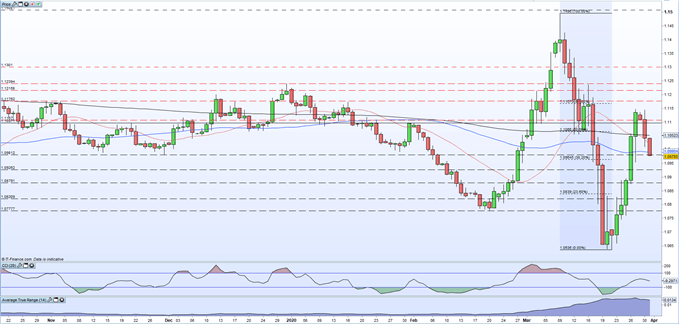EUR/USD Price, Chart, and Analysis
- US inflation – Core PCE (February) – expected to rise to 5.5%
- Hot EU inflation keeps the pressure on the ECB to hike rates.
- EUR/USD is likely to remain volatile in the short term.
The February US PCE release – The Federal Reserve’s preferred measure of inflation – will hit the screens at 13:30 UK today and is expected to show price pressures ramping up further. The January core reading of 5.2% showed inflation running at its highest level since April 1983 and today’s number is expected to climb further, with the market expecting a year-on-year reading of 5.5%. Today’s release, if expectations are met or beaten, will stiffen the Fed’s resolve to hike interest rates by 50 basis points at the next FOMC meeting in May and, if these price pressures persist, at the June meeting as well.
For all market-moving data releases and events, see the DailyFX Economic Calendar
The European Central Bank is also under pressure to raise interest rates as price pressures soar in the single block. Annual inflation in the Euro Area currently stands at 5.9% and is currently seen hitting a fresh record high of 6.6% in March. The ECB will need to tighten monetary policy quickly to quell inflation and prevent prices from spiraling out of its control.
The single currency has been pricing in these rate hike expectations in the EU over the last three weeks, helping to drag EUR/USD from a near two-year low of 1.0800 on March 7 to a fraction under 1.1200 in yesterday’s session. The pair slipped back to 1.1100 today as traders turn their focus on the US PCE release this afternoon. EUR/USD volatility remains high and the CCI indicator continues to flash an overbought EUR/USD warning. With quarter-end portfolio rebalancing added to the mix, expect volatility to remain high going into the weekend.
EUR/USD Daily Price Chart – March 31, 2022
Retail trader data show 54.28% of traders are net-long with the ratio of traders long to short at 1.19 to 1. The number of traders net-long is 2.26% lower than yesterday and 13.31% lower from last week, while the number of traders net-short is 7.16% higher than yesterday and 17.62% higher from last week.
We typically take a contrarian view to crowd sentiment, and the fact traders are net-long suggests EUR/USD prices may continue to fall. Yet traders are less net-long than yesterday and compared with last week. Recent changes in sentiment warn that the current EUR/USD price trend may soon reverse higher despite the fact traders remain net-long.
What is your view on the EURO – bullish or bearish?? You can let us know via the form at the end of this piece or you can contact the author via Twitter @nickcawley1.
Read More:EUR/USD Slides Ahead of Major US Inflation Release
2022-03-31 11:00:00

